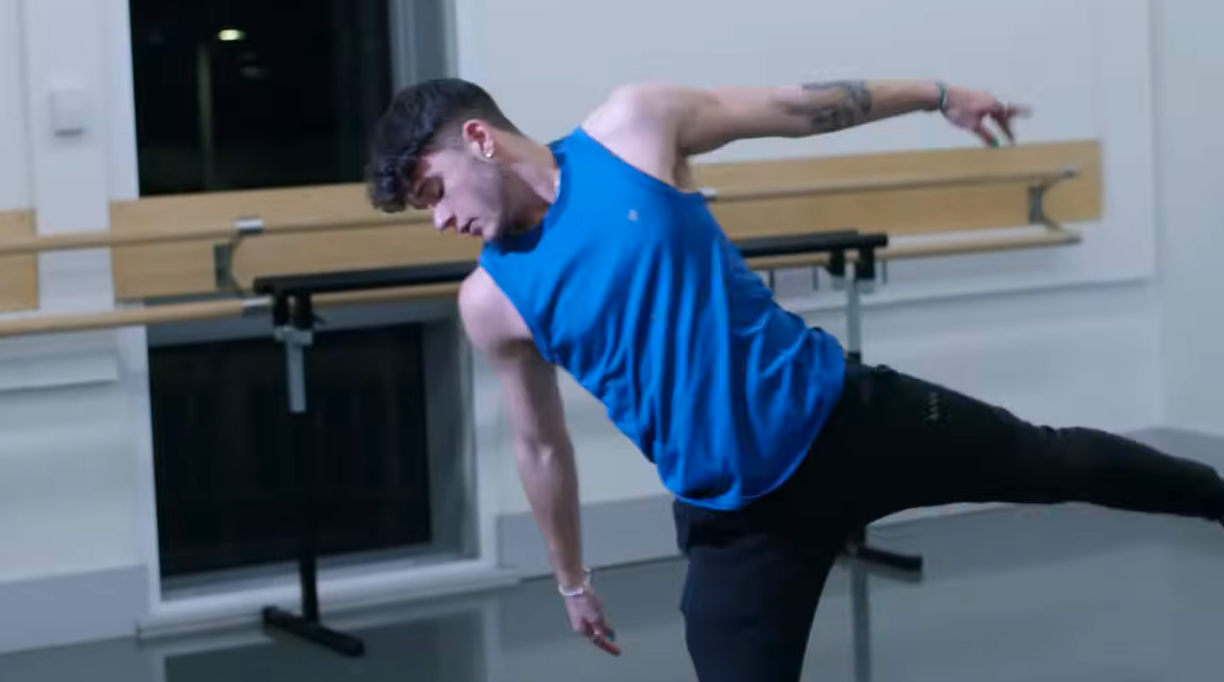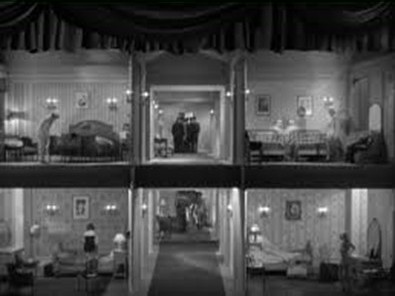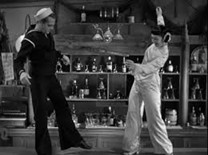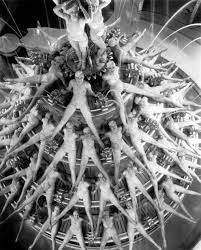the vulgarians at the gate
by Douglas Messerli
Manuel Seff and James Seymour (writers, based on a story by
Robert Lord and Peter Milne [uncredited]), Lloyd Bacon (director), Busby
Berkeley (dance numbers) Footlight
Parade / 1933
By
coincidence, the same week in July when Howard and I attended a local large
screen showing of James Cagney’s Yankee
Doodle Dandy, Netflix sent me a DVD of Cagney’s 1933 film, Footlight Parade, enabling me to see
Cagney as a hoofer twice. He got far more screen time and far better dances in Yankee, but as an actor Cagney is more
energetic and far more frenetic in Footlight;
when the camera’s on him, there’s hardly a moment when the former Broadway
director, Chester Kent, isn’t cooking up a new dance, booking a new movie house
for his “musical prologues,” interviewing a new cast member, or simply
strutting from room to room wherein his mini-factory of rehearsal halls he
tries out numerous numbers (both musical and human) simultaneously.

Battered equally by his producer’s wife,
Harriet Bowers Gould (Ruth Donnelly), who troops in an army of would-be
protégés (including Dick Powell as Scotty Blair), and the same producer’s
nay-saying brother, Charlie Bowers (Hugh Herbert), who would like to censor
every act that Kent cooks up, Kent is caught up in a near whirlwind of
moment-to-moment changes. The movie, filmed just before the establishment of
the Film Production Code, joyfully makes fun of what clearly the writers and
directors saw coming, as Bowers demands the dolls—toy dolls, not the real
girls—sport brassieres ("...uh uh, you know Connecticut.") at the
very same moment that Kent is transforming his scantily clad dancers into
yowling cats and the film’s director is dishing out a gay satire in which Dick
Powell sings of his love, arms about his cigar-munching musical director, a
stand-in for any would-be lover.

Fortunately, Kent has the level-headed and
seemingly unflappable, Nan Prescott (Joan Blondell) by his side, a secretary so
confident that the film suggests she could run the place, even if—given the
machinations of Kent’s former wife, Cynthia (Renee Whitney) and Nan’s gold
digger friend, Vivian Rich (Claire Dodd)—she can’t always be as sure of her
man. Fortunately, he’s too busy to spend much time but a lunch date with other
women.
Besides, he has
choruses of loving boys and girls at his at the flip of his wrist, and it’s
those lovelies that are truly the focus of this film; just to make sure,
plain-looking secretary, Bea Thorn (Ruby Keeler), who has secretly (even to
her) fallen in love with Scotty Blair, decides to marcel her hair and jump into
the larger pool.
Although the film was directed by the always sturdy Lloyd Bacon, the
dance and musical numbers, at the heart of this extremely light-hearted work,
came directly from the overheated imagination of Busby Berkeley, who in this
movie went all out in the work’s featured three “prologues,” “Honeymoon Hotel”
(Harry Warren, music and Al Dubin, lyrics), “Shanghai Lil” (by the same duo),
and “By a Waterfall” (by Sammy Fain, music and Irving Kahal, lyrics). As if the
numerous sexual innuendoes of the first song, performed supposedly on-stage in
a hotel-sized set, were not enough, Bacon links up the three numbers by busing
the girls from theater to theater, while we glimpse them openly changing
costumes.
Berkeley’s
“Shanghai Lil” gives Cagney a terpsichorean turn with Ruby Keeler impersonating
his Chinese prostitute girlfriend, much in the way that Gene Kelly courted Cyd
Charisse in Singing in the Rain.
But it is in “By a Waterfall,” with Dick
Powell croons out his love to Keeler that really gets the full Berkeley
treatment and presages his several later Ester Williams musicals. I could
hardly describe the scene better that does John Wakeman’s World Film Directors, Volume One.
“The camera
then pulls back to reveal the waterfall itself
with Berkeley girls sliding down it like half-naked nymphs. retreating
still further to disclose an immense pool where the girls dive, swim, and float
to form geometric patterns that fold and unfold like flowers, separate and rejoin
in new shapes, and finally assemble themselves into a multitiered human
fountain from which water cascades into the pool.”
As critic Arthur Knight summarizes,
through the dance’s numerous fragmented shots, “It is the camera that is doing
the dancing, not the chorines!”
Strangely, by so
forcefully featuring these supposedly “on stage” elaborated numbers, Footlight Parade makes it clear why the
footlights of Broadway theater are no longer appealing. Instead of “real”
dancers, the camera is now both spectator and spectacle, an observer who in the
hands of someone like Berkeley, itself becomes the center of attention. Kent
can longer direct his Broadway works because the “vulgarians” are at the gate,
the talkies representing a kind of second-hand theatrics that speak in the
language of technology instead of true singing and dancing human voice and
bodies. Human beings have been collectivized to become the troops of war—a war,
in this case, against the live actors featured on the stage.
It’s strange
that this and other Berkeley movies so clearly made it apparent that motion
pictures were not what they pretended to be. Yet can any one of us easily turn
our gazes away from such cinematic feats?
Los Angeles,
July 11, 2017
Reprinted from World
Cinema Review (July 2017).










